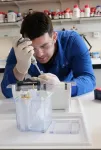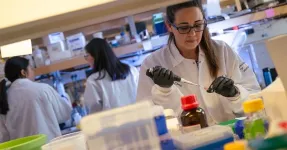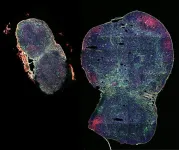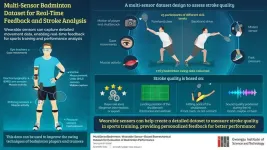PORTLAND, Oregon – About 79% of clinical trial participants experienced measurable improvement after receiving experimental, CRISPR-based gene editing that is designed to fix a rare form of blindness, according to a paper published in the New England Journal of Medicine.
“This trial shows CRISPR gene editing has exciting potential to treat inherited retinal degeneration,” said Mark Pennesi, M.D., Ph.D., a corresponding author on the paper, an ophthalmologist and Oregon Health & Science University’s lead scientist for the Phase 1/2 BRILLIANCE trial and a corresponding author on the paper. “There is nothing more rewarding to a physician than hearing a patient describe how their vision has improved after a treatment. One of our trial participants has shared several examples, including being able to find their phone after misplacing it and knowing that their coffee machine is working by seeing its small lights. While these types of tasks might seem trivial to those who are normally sighted, such improvements can have a huge impact on quality of life for those with low vision.”
The trial evaluated the safety and effectiveness of EDIT-101, an experimental gene editing treatment that uses CRISPR technology and was developed by Editas Medicine. The experimental treatment was specifically designed to edit a mutation in the CEP290 gene, which provides instructions to create a protein that is critical for sight.
People with this mutation have a rare condition that is commonly called Leber Congenital Amaurosis, or LCA, Type 10, for which there is no treatment available. LCA’s various types occur in a total of about 2 or 3 out of 100,000 newborns.
The OHSU Casey Eye Institute treated the trial’s first participant in early 2020. That procedure also marked the first time that CRISPR had been used to edit genes within the human body, which is also called in vivo gene editing.
Today’s paper describes the study’s findings through February 2023, and details how the trial’s 14 participants –12 adults of whom were adults, while two were children – responded to receiving EDIT-101 in one eye. Key results include:
11 participants, or about 79%, showed improvement in at least one of four measured outcomes.
6 participants, or about 43%, showed improvement in two or more outcomes.
6 participants, or about 43%, reported improved vision-related quality of life.
4 participants, or about 29%, had clinically meaningful improvement in visual acuity, or how well they could identify objects or letters on a chart.
There were no treatment-related serious adverse events.
Most adverse events were mild or moderate, and all have since been resolved.
Four specific outcomes were used to evaluate the experimental treatment’s effectiveness:
visual acuity, as described above
how well participants saw colored points of light while looking into a specialized device, which scientists call a full-field test
how well participants navigated a research maze with physical objects and varying amounts of light
how much participants reported experiencing improved quality of life
This is the first time that the trial’s results have been published in a peer-reviewed scientific journal. Previously, interim results had been shared through conference presentations by investigators and in press releases issued by the trial sponsor.
Further research for a future treatment
In November 2022, trial sponsor Editas Medicine announced that it was pausing the trial’s enrollment and would seek another partner to continue the experimental therapy’s development. Pennesi and colleagues are exploring working with other commercial partners to conduct additional trials, in collaboration with Editas. The researchers hope future studies can examine ideal dosing, whether a treatment effect is more pronounced in certain age groups such as younger patients, and include refined endpoints to measure impacts on activities of daily living.
“This research demonstrates that CRISPR gene therapy for inherited vision loss is worth continued pursuit in research and clinical trials,” said Mass Eye & Ear ophthalmologist Eric Pierce, M.D., Ph.D., who is also a corresponding author. “While more research is needed to determine who may benefit most, we consider the early results promising. To hear from several participants how thrilled they were that they could finally see the food on their plates – that is a big deal. These were individuals who could not read any lines on an eye chart and who had no treatment options, which is the unfortunate reality for most people with inherited retinal disorders.”
“Our patients are the first congenitally blind children to be treated with gene editing, which significantly improved their daytime vision,” said the paper’s third corresponding author, Tomas S. Aleman, M.D., a pediatric ophthalmologist at the Children’s Hospital of Philadelphia and the University of Pennsylvania’s Scheie Eye Institute. “Our hope is that the study will pave the road for treatments of younger children with similar conditions and further improvements in vision. This trial represents a landmark in the treatment of genetic disease, in specific genetic blindness, by offering important alternative treatment when traditional forms of therapy, such as gene augmentation, are not an option.”
“The results from the BRILLIANCE trial provide proof of concept and important learnings for the development of new and innovative medicines for inherited retinal diseases. We’ve demonstrated that we can safely deliver a CRISPR-based gene editing therapeutic to the retina and have clinically meaningful outcomes,” said Editas Medicine Chief Medical Officer Baisong Mei, M.D., Ph.D.
The OHSU Casey Eye Institute is one of five clinical sites that recruited participants for the trial. The other sites are: Bascom Palmer Eye Institute in Miami, Florida; Mass Eye and Ear in Boston, Massachusetts; Scheie Eye Institute at the University of Pennsylvania and Children’s Hospital of Philadelphia; and Kellogg Eye Center in Ann Arbor, Michigan.
REFERENCE: Eric A. Pierce, Tomas S. Aleman, Kanishka T. Jayasundera, Bright S. Ashimatey, Keunpyo Kim, Alia Rashid, Michael Jaskolka, Rene L. Myers, Bryon L. Lam, Steven T. Bailey, Jason I. Commander, Andreas K. Lauer, Albert M. Maguire, Mark E. Pennesi, Gene-editing for CEP290-associated Retinal Degeneration, New England Journal of Medicine, May 6, 2023, DOI: 10.1056/NEJMoa2309915.
This research was supported by Editas Medicine, the National Institutes of Health’s National Eye Institute (grants P30 EY014104 and P30 EY010572), Malcolm M. Marquis MD Endowed Fund for Innovation, Research to Prevent Blindness (unrestricted grants to OHSU Casey Eye Institute and University of Pennsylvania’s Scheie Eye Institute), the Irene Heinz Given and John LaPorte Given Endowment, and Hope for Vision.
This content is solely the responsibility of the authors and does not necessarily represent the official views of the National Institutes of Health.
In the interest of ensuring the integrity of our research and as part of our commitment to public transparency, OHSU actively regulates, tracks and manages relationships that our researchers may hold with entities outside of OHSU. In regards to this research, Dr. Mark Pennesi has received payments for consulting from Editas Medicine. Review details of OHSU's conflict of interest program to find out more about how we manage these business relationships.
END





